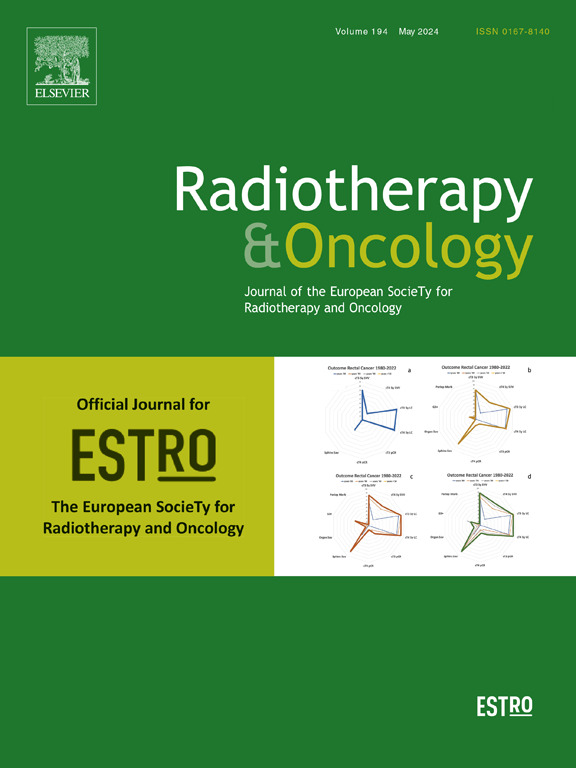Effect of glioblastoma and brain radiotherapy on T-lymphocyte subpopulations in rodents
IF 4.9
1区 医学
Q1 ONCOLOGY
引用次数: 0
Abstract
Introduction
Although lymphopenia is linked to immune suppression favoring tumor growth, the effect of different radiation types on specific T-lymphocyte subsets remains unclear. Among the T-lymphocyte subpopulations, CD8+-lymphocytes serve as key effectors in cancer immunity. This study aimed to examine the changes in T-lymphocyte subpopulations in both tumor-free and glioblastoma-bearing mice following brain-irradiation.
Methods
The study was divided into two main phases. First, C57BL/6 mice, with or without glioblastoma (GL261 cells), received hemispheric brain-irradiation or no-treatment. T-lymphocyte subpopulations were analyzed using flow cytometry at various timepoint. The effect of tumor size and brain-irradiation on these cells was assessed using correlation analysis. Next, C57BL/6 mice were subjected to different brain-irradiation conditions. Blood samples were collected during and post-irradiation to analyze T-lymphocyte subpopulations, and tree-based modeling was used to determine radiation parameters impact on naïve CD8+-lymphocyte levels.
Results
Glioblastoma reduced all T-lymphocyte subpopulations by day 15 post-inoculation. Radiotherapy decreased regulatory and effector CD4+-lymphocytes in both tumor-free and glioblastoma-bearing mice, but not naïve or memory CD4+-lymphocytes, in both tumor-free and glioblastoma-bearing mice. In tumor-free mice, radiotherapy had no effect on CD8+-lymphocytes, but reduced all CD8+-lymphocyte types in glioblastoma-bearing mice. Glioblastoma size negatively affected CD8+-lymphocytes. Brain-irradiation persistently reduced naïve and memory CD8+-lymphocytes, but effector and regulatory T-lymphocytes recovered. Exposure of lymph nodes to radiation worsened CD8+-lymphocyte reduction.
Conclusion
These findings confirm that the presence of glioblastoma and brain-irradiation affect T-lymphocyte subpopulations in mice. The inclusion of lymph nodes in the irradiated area led to a long-term decrease in naïve CD8+-lymphocytes. Further mechanistic studies are needed to understand the molecular basis of radiation impact on T-lymphocyte subpopulations.
胶质母细胞瘤和脑放疗对啮齿动物t淋巴细胞亚群的影响。
虽然淋巴细胞减少与有利于肿瘤生长的免疫抑制有关,但不同辐射类型对特定t淋巴细胞亚群的影响尚不清楚。在t淋巴细胞亚群中,CD8+淋巴细胞在肿瘤免疫中起关键作用。本研究旨在研究脑辐照后无肿瘤小鼠和患胶质母细胞瘤小鼠t淋巴细胞亚群的变化。方法:研究分为两个主要阶段。首先,有或没有胶质母细胞瘤(GL261细胞)的C57BL/6小鼠接受脑半球照射或不治疗。用流式细胞术分析不同时间点的t淋巴细胞亚群。通过相关分析评估肿瘤大小和脑辐照对这些细胞的影响。然后,对C57BL/6小鼠进行不同的脑辐照条件。在照射期间和照射后采集血液样本分析t淋巴细胞亚群,并使用基于树的模型确定辐射参数对naïve CD8+淋巴细胞水平的影响。结果:胶质母细胞瘤在接种后第15天减少了所有t淋巴细胞亚群。放疗降低了无瘤小鼠和胶质母细胞瘤小鼠的调节性和效应性CD4+-淋巴细胞,但在无瘤小鼠和胶质母细胞瘤小鼠中,naïve或记忆性CD4+-淋巴细胞没有下降。在无肿瘤小鼠中,放疗对CD8+淋巴细胞没有影响,但在胶质母细胞瘤小鼠中,放疗降低了所有CD8+淋巴细胞类型。胶质母细胞瘤大小对CD8+淋巴细胞有负性影响。脑辐照持续降低naïve和记忆性CD8+淋巴细胞,但效应t淋巴细胞和调节性t淋巴细胞恢复。淋巴结暴露于辐射使CD8+淋巴细胞减少。结论:这些发现证实了胶质母细胞瘤的存在和脑辐照对小鼠t淋巴细胞亚群的影响。在放疗区淋巴结的包含导致naïve CD8+-淋巴细胞的长期减少。需要进一步的机制研究来了解辐射对t淋巴细胞亚群影响的分子基础。
本文章由计算机程序翻译,如有差异,请以英文原文为准。
求助全文
约1分钟内获得全文
求助全文
来源期刊

Radiotherapy and Oncology
医学-核医学
CiteScore
10.30
自引率
10.50%
发文量
2445
审稿时长
45 days
期刊介绍:
Radiotherapy and Oncology publishes papers describing original research as well as review articles. It covers areas of interest relating to radiation oncology. This includes: clinical radiotherapy, combined modality treatment, translational studies, epidemiological outcomes, imaging, dosimetry, and radiation therapy planning, experimental work in radiobiology, chemobiology, hyperthermia and tumour biology, as well as data science in radiation oncology and physics aspects relevant to oncology.Papers on more general aspects of interest to the radiation oncologist including chemotherapy, surgery and immunology are also published.
 求助内容:
求助内容: 应助结果提醒方式:
应助结果提醒方式:


